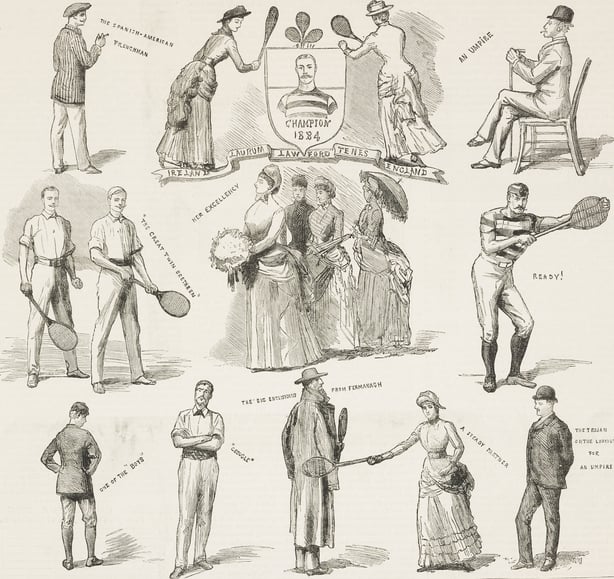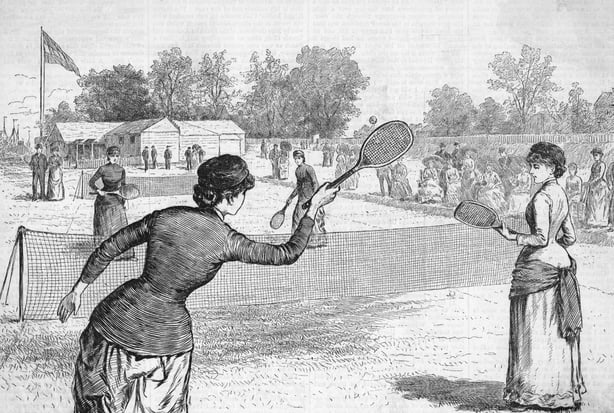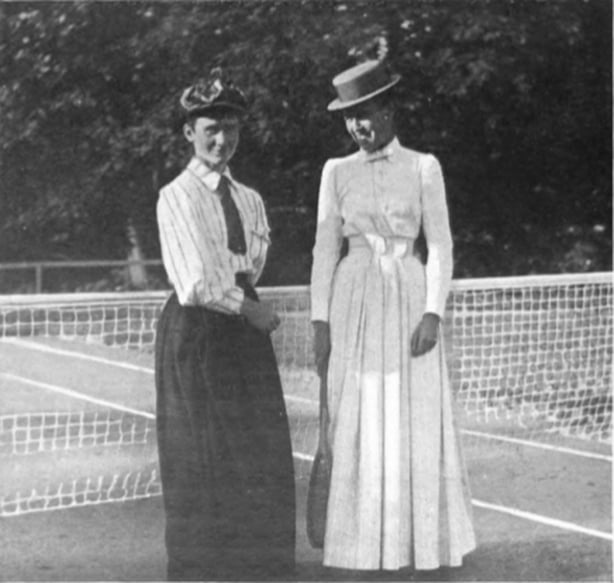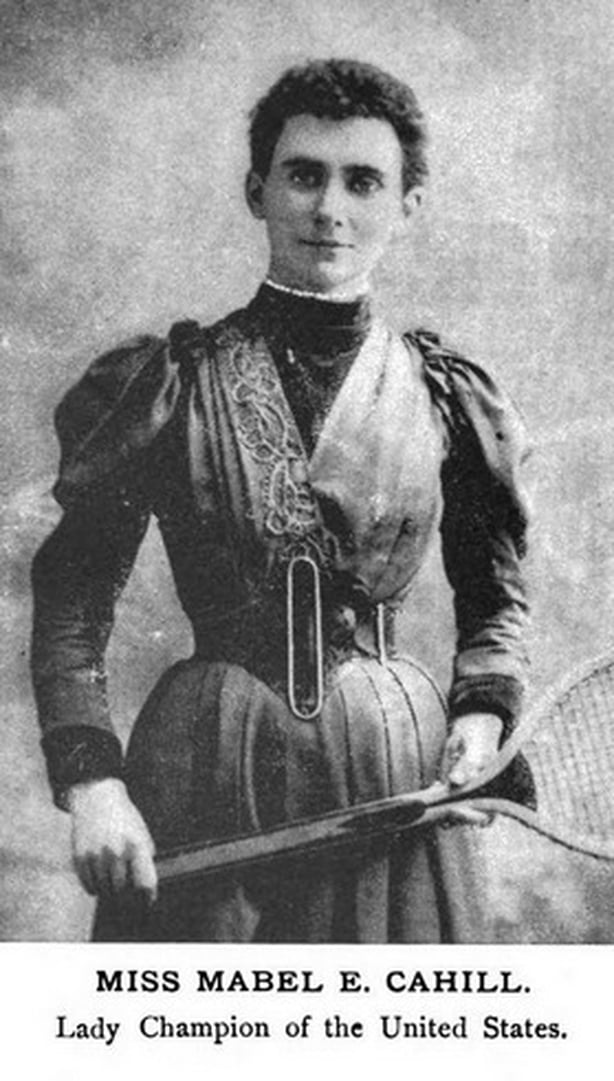She was Victorian Ireland's most celebrated female tennis player, and a move to the United States brought her more success - but she ended her life in poverty. In this extract from the Dictionary of Irish Biography's new book Irish Sporting Lives, Paul Rouse tells the story of Mabel Cahill
Mabel Cahill was born 2 April 1863 in Ballyragget, Co. Kilkenny, twelfth of thirteen children of Michael Cahill, gentleman landowner and barrister-at-law, of Ballyconra House, Ballyragget, and his first wife, Margaret (née Magan), Ballymore, Co. Westmeath (1823–c.1875). Born into a Catholic gentry family, she attended school in Roscrea, Co. Tipperary, probably the Sacred Heart Convent School.
Mabel and her siblings were drawn into lawn tennis parties and tournaments, the craze for lawn tennis having swept through Ireland from the late 1870s. In 1884 she appears in her first recorded tennis competition, the Kilkenny County and City Tournament held in Archersfield, which she won playing off a handicap. (Unlike 'open' events, handicaps gave lesser players scoring advantages.) During 1884–6 she participated regularly in other lawn tennis tournaments held across Ireland, including Dublin’s prestigious Fitzwilliam Square tournament in 1886, where she lost 6–0, 6–1 in the first round of the open event.

For the rest of the 1886 season, she focused mainly on handicap singles events, winning this event at the Lansdowne Lawn Tennis Club Tournament in Dublin; playing off ‘scratch’, she also claimed the handicap event at the Kilkenny County and City Tournament in Archersfield. She does not seem to have participated in tennis tournaments in Ireland during 1887–9.
Mabel takes Manhattan
Emigrating to New York City, most likely first arriving there on 7 October 1889, she lived in Manhattan – alongside Central Park – and began playing tennis on the new courts built there. Her brother Louis, who was also living in New York, became a regular tennis partner.
Entering the Annual Invitation Ladies’ Tournament at the Staten Island Cricket Club in autumn 1889, she won the ladies’ singles and mixed doubles events. While she had been outmatched in first class open events in Ireland, she found the standard of tennis to be lower in America. Her tennis also improved after she came to America, something she credited to practising regularly against men.

She became a member of the New York Tennis Club in 1890, the year she travelled to Philadelphia for the United States Championship, being the only non-American of the eight women to compete in the singles event. The format of the singles championship saw the defending champion progress automatically to the final, where she would play the winner of a knockout competition played between all other entrants.
Cahill reached the final of the knockout competition, but a foot cramp in the deciding set forced her out of her match against the eventual champion Ellen Roosevelt, a first cousin of future US President Franklin D. Roosevelt. Believing herself wronged by the match officials, who refused her more time to recover, the fiery Cahill bore a grudge against Roosevelt over this incident.
She returned to the US Championship in 1891 to defeat both Ellen Roosevelt and her sister Grace in claiming the singles honours. The final victory over Ellen Roosevelt was 6–4, 6–1, 4–6, 6–3, the best of five sets format having been introduced that year for the US Championship, which reverted to best of three sets after 1901. She then added the women’s doubles (with Emma Fellowes-Morgan), defeating the Roosevelt sisters in a close, best-of-three-sets final, along with the mixed doubles (with Marion Wright), though this event did not have championship status.

In the 1892 United States Championship she claimed the ladies’ singles, ladies’ doubles and mixed doubles, the last now a championship event, becoming the first person to record a treble at a major tennis tournament. The ladies’ doubles and mixed doubles were won easily in partnership respectively with Adeline McKinley and Clarence Hobart, but she had to fight hard in the singles final against Bessie Moore, eventually prevailing 5–7, 6–3, 6–4, 4–6, 6–2.
Moore, who had looked the likely winner going into the final set, tired after staying outside during the interval while Cahill cooled indoors for longer than was stipulated. Women were then obliged to play tennis in suffocating attire comprising heeled boots, long sleeves, headgear, a necktie or scarf and an ankle-length dress over a petticoat and corset, all supported by a girdle.
Sporting star
Mabel Cahill was now a sporting star and a syndicated article about her ('Mabel Cahill – Lawn Tennis Champion') appeared in the American press in 1892. It described her as ‘a petite, attractive brunette, with short black hair, and the brightest of grey eyes, full of life and spirits’.

Newspaper reports refer to her ‘manliness’, describe her preparation as more like that of a professional than of an amateur, and pay tribute to her energy around the court and to the ferocity of her groundstrokes. Few opponents could cope with her serve, which she almost invariably delivered overhand, a tactic considered unusual enough to be noteworthy. In 1891 she observed that women who played the tennis ball gracefully from the wrist rather than from the shoulder were putting themselves at a competitive disadvantage.
She also competed in various American tennis tournaments during 1890–93, never losing a completed singles match in the USA. She was not a popular champion and had to withstand the hostility of both spectators and match opponents. It is unclear whether this was on account of her playing style or of her foreign birth. For all that, her American rivals were soon emulating her dedication, energy and power.
Her final appearance in open events in first class lawn tennis came in July 1893 at the New York State Championships. Tennis was an amateur sport, and it is likely that the income she inherited from her father’s estate had run out.
The post-tennis years
From the early 1890s she tried to become a professional writer, publishing a novel in New York entitled Her Playthings, men (1891). It was not a success; neither were her shorter works – Carved in Marble (1892) and Purple Sparkling (1892). She dabbled in journalism and published articles on tennis in journals, wherein she denied the frequently expressed view that the exertions of tennis were bad for women’s health. By 1896 at the latest, when she was described as a professional rider, she was participating in equestrian events. She also hunted as a member of the Ocean County Hunt and Country Club in Lakewood, New Jersey.
Moving to London, she stayed briefly in a workhouse in April 1897, probably upon her arrival. She struggled to earn enough money writing articles for magazines and performing on stage in music halls where she sang and acted, often as a chorus girl, in variety shows and burlesques. She was still in London in January 1900 but living in Ormskirk, Lancashire, by the start of 1905, drawn presumably by the work going in the seaside music halls of nearby Blackpool and Southport. Stricken with tuberculosis, Mabel Cahill died in the Union Workhouse, Ormskirk, on 2 February 1905. Three days later she was buried in a pauper’s grave in the graveyard of the church of Saint Peter and Saint Paul. Her death went unnoticed, and her last years were for long a mystery. In 1976 she was inducted into the International Tennis Hall of Fame.
Irish Sporting Lives brings to life sixty figures who in their individual ways illustrate the drama and diversity of Irish sporting history. Spanning 200 years, the biographical essays in Irish Sporting Lives incluide trailblazing women as well as serial winners and glorious losers, heroes and villains, role models and rogues, enduring legends and forgotten or overlooked greats.
Irish Sporting Lives is available now from all good bookshops and can be ordered here at www.ria.ie/isl
The sixty lives included in Irish Sporting Lives are drawn from Ireland's national biographical dictionary, the Dictionary of Irish Biography. Find out more at www.dib.ie
Sources: Frank Leslie’s Illustrated Newspaper, 16 August 1890; Illustrated American, 23 May 1891; Mabel Cahill, ‘The English and Irish girl champions’, Valentine G. Hall (ed.), Wright & Ditson officially adopted lawn tennis guide (1891), 137–41; Town topics, the Journal of society, 22 June 1893; Case #1020, Probate Register (Michael Netterville Cahill [sic]), Early California wills (1952), vol. 1, 78, transcribed at Cal Data Nook, SF Genealogy, www.sfgenealogy.com (internet material accessed August 2011); John Gleeson (ed.), Fyffes dictionary of Irish sporting greats (1993); Ralph Hickok, A who’s who of sports champions: their stories and records (1995); Joan N. Burstyn (ed.), Past and promise: lives of New Jersey women (1997), 173–4; Tom Higgins, The history of Irish tennis (2006); Mark Ryan, ‘Mabel Cahill – Lawn Tennis champion, writer, stage actress’, www.tennisforum.com (internet material accessed August 2020)














































